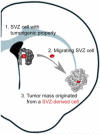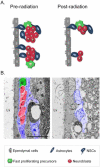Implications of irradiating the subventricular zone stem cell niche
- PMID: 26921873
- PMCID: PMC8442998
- DOI: 10.1016/j.scr.2016.02.031
Implications of irradiating the subventricular zone stem cell niche
Abstract
Radiation therapy is a standard treatment for brain tumor patients. However, it comes with side effects, such as neurological deficits. While likely multi-factorial, the effect may in part be associated with the impact of radiation on the neurogenic niches. In the adult mammalian brain, the neurogenic niches are localized in the subventricular zone (SVZ) of the lateral ventricles and the dentate gyrus of the hippocampus, where the neural stem cells (NSCs) reside. Several reports showed that radiation produces a drastic decrease in the proliferative capacity of these regions, which is related to functional decline. In particular, radiation to the SVZ led to a reduced long-term olfactory memory and a reduced capacity to respond to brain damage in animal models, as well as compromised tumor outcomes in patients. By contrast, other studies in humans suggested that increased radiation dose to the SVZ may be associated with longer progression-free survival in patients with high-grade glioma. In this review, we summarize the cellular and functional effects of irradiating the SVZ niche. In particular, we review the pros and cons of using radiation during brain tumor treatment, discussing the complex relationship between radiation dose to the SVZ and both tumor control and toxicity.
Keywords: Brain tumor; Neural stem cells; Neurogenesis; Radiation; Subventricular zone.
Copyright © 2016. Published by Elsevier B.V.
Figures




Similar articles
-
Grafted Subventricular Zone Neural Stem Cells Display Robust Engraftment and Similar Differentiation Properties and Form New Neurogenic Niches in the Young and Aged Hippocampus.Stem Cells Transl Med. 2016 Sep;5(9):1204-15. doi: 10.5966/sctm.2015-0270. Epub 2016 May 18. Stem Cells Transl Med. 2016. PMID: 27194744 Free PMC article.
-
Persistent Cyfip1 Expression Is Required to Maintain the Adult Subventricular Zone Neurogenic Niche.J Neurosci. 2020 Mar 4;40(10):2015-2024. doi: 10.1523/JNEUROSCI.2249-19.2020. Epub 2020 Jan 27. J Neurosci. 2020. PMID: 31988061 Free PMC article.
-
The subventricular zone is able to respond to a demyelinating lesion after localized radiation.Stem Cells. 2014 Jan;32(1):59-69. doi: 10.1002/stem.1519. Stem Cells. 2014. PMID: 24038623 Free PMC article.
-
The Organism as the Niche: Physiological States Crack the Code of Adult Neural Stem Cell Heterogeneity.Annu Rev Cell Dev Biol. 2024 Oct;40(1):381-406. doi: 10.1146/annurev-cellbio-120320-040213. Epub 2024 Sep 21. Annu Rev Cell Dev Biol. 2024. PMID: 38985883 Review.
-
Overlapping migratory mechanisms between neural progenitor cells and brain tumor stem cells.Cell Mol Life Sci. 2019 Sep;76(18):3553-3570. doi: 10.1007/s00018-019-03149-7. Epub 2019 May 17. Cell Mol Life Sci. 2019. PMID: 31101934 Free PMC article. Review.
Cited by
-
Therapy Resistance of Glioblastoma in Relation to the Subventricular Zone: What Is the Role of Radiotherapy?Cancers (Basel). 2023 Mar 9;15(6):1677. doi: 10.3390/cancers15061677. Cancers (Basel). 2023. PMID: 36980563 Free PMC article.
-
The Strange Case of Jekyll and Hyde: Parallels Between Neural Stem Cells and Glioblastoma-Initiating Cells.Front Oncol. 2021 Jan 8;10:603738. doi: 10.3389/fonc.2020.603738. eCollection 2020. Front Oncol. 2021. PMID: 33489908 Free PMC article. Review.
-
Human Mesenchymal Stem Cells Prevent Neurological Complications of Radiotherapy.Front Cell Neurosci. 2019 May 16;13:204. doi: 10.3389/fncel.2019.00204. eCollection 2019. Front Cell Neurosci. 2019. PMID: 31156392 Free PMC article.
-
Olfactory bulb plasticity ensures proper olfaction after severe impairment in postnatal neurogenesis.Sci Rep. 2017 Jul 18;7(1):5654. doi: 10.1038/s41598-017-05970-1. Sci Rep. 2017. PMID: 28720887 Free PMC article.
-
Bcl2-Expressing Quiescent Type B Neural Stem Cells in the Ventricular-Subventricular Zone Are Resistant to Concurrent Temozolomide/X-Irradiation.Stem Cells. 2019 Dec;37(12):1629-1639. doi: 10.1002/stem.3081. Epub 2019 Oct 17. Stem Cells. 2019. PMID: 31430423 Free PMC article.
References
-
- Stupp R, et al. Effects of radiotherapy with concomitant and adjuvant temozolomide versus radiotherapy alone on survival in glioblastoma in a randomised phase III study: 5-year analysis of the EORTC-NCIC trial. Lancet Oncol. 2009;10:459–466. doi: 10.1016/S1470-2045(09)70025-7. - PubMed
-
- Stupp R, et al. Radiotherapy plus concomitant and adjuvant temozolomide for glioblastoma. N Engl J Med. 2005;352:987–996. doi: 10.1056/NEJMoa043330. - PubMed
-
- DeAngelis LM. Chemotherapy for brain tumors--a new beginning. N Engl J Med. 2005;352:1036–1038. doi: 10.1056/NEJMe058010. - PubMed
-
- Rusthoven CG, et al. The impact of adjuvant radiation therapy for high-grade gliomas by histology in the United States population. International journal of radiation oncology, biology, physics. 2014;90:894–902. doi: 10.1016/j.ijrobp.2014.07.046. - PubMed
Publication types
MeSH terms
Grants and funding
LinkOut - more resources
Full Text Sources
Other Literature Sources
Miscellaneous

